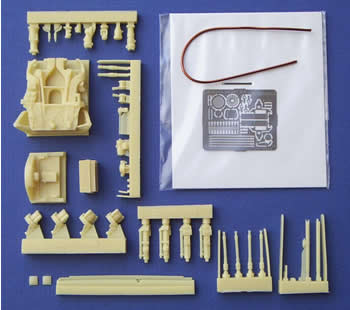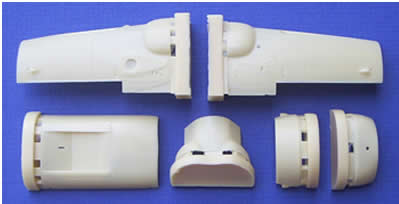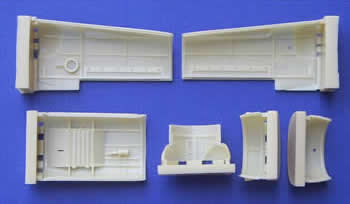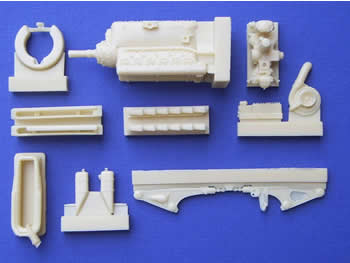Aires | Bf 109G-6 Engine Detail Set
Reviewed by Steve Messer

The release of Hasegawa's 1/32nd scale Messerschmitt Bf109 G6 in 2001 was a blessing for many in the large-scale modelling community, and has since spawned many other variants of the '109 through clever design of the kit's moulds. But for all it's detail, it's what the Auto fraternity would call a "curbside", having no detail whatsoever. For those wishing to further enhance their '109, Czech aftermarket supplier Aires have filled the breach with their multi-media kit No.2017, Messerschmitt Bf 109 Engine Set.

This set includes just about everything from the fire-wall forward; with 57 butter-coloured resin parts, a small photo-etched fret, length of copper wire, and a basic instruction sheet. However, parts not included are; the spinner and prop assembly, lower chin radiator housing and port-side air intake, these will need to be sourced from the Hasegawa kit or another aftermarket supplier if so desired. And needless to say, some radical surgery to the front end of the Hasegawa kit will be required. The resin parts are well moulded, bubble free, and suitably robust or delicate where required.
The DB605 engine is nicely detailed, and appears dimensionly accurate. The gear casing is moulded integrally to the engine's front, ensuring correct allignment of the prop shaft, however the shaft itself is a little too thick to fit the kit spinner assembly, and will need to be replaced with Hasegawa part number M15 or rod of the appropriate diameter if you wish to mount the spinner. Other engine parts supplied include; engine bearers, coolant lines and header tanks, compressor and magneto, front oil tank, exhaust "window boxes" and nicely hollowed exhaust stacks. The firewall insert is a little work of art; busy with ammo chutes, engine cannon cavity, undercarriage "knuckles" and convenient locator holes to accept the tabs in the ends of the engine bearers. The MG 131's have fine barrel detail, and as there are four included in the pack, you get a couple extra for the spares box!



Now for the cowlings... seven parts in all; two main cowlings,a thin piano hinge to separate them, rear MG cover, upper and lower oil tank covers, and lastly the lower engine oil radiator cover. All have lovely internal ribbed detail, and are almost wafer thin in places to suggest thinness of scale. The exteriors seem to be closely patterned after the Hasegawa kit's details, right down to the offset nature of the front cowling scoops... There seems to be some debate as to whether this is accurate, but if the main cowlings are posed open, you'd hardly notice either way. On the other hand, the latches on the MG cover are clearly visible on the new casting, whereas these latches would normally be covered by the "beule" bumps if you were to make up the Hasegawa kit as per the instructions, so there has at least been some thought put in to make this area more accurate. The separate casting of these cowling parts allows the modeller complete choice as to how many are attached to the airframe, or left off to display in a diorama setting, as the case may be.
Also included are resin representations of the upper MG platform and underside oil cooler radiator. The gun platform is fine, but the radiator matrix detail is poor, and would have been better represented in photo-etch... Speaking of which, the addition of a small fret with engine and cowl latch details is a nice touch. Finally, the small instruction sheet provided is clear without being confusing, but lacks any painting information whatsoever.
In conclusion, this is the perfect detail set for the experienced modeller looking for a departure from the standard '109 kit, or as a basis for a show-stopper. The detail of the contents provided is accurate and well executed, the set only being let down by the detail of one resin part and the absence of a colour guide for items that aren't covered by the donor kit's instruction sheet. However, this matters little in the long run, as the majority of builders will probably have their own reference photos at hand. So in short, highly recommended.
© Steve Messer 2006
This review was published on Saturday, July 02 2011; Last modified on Wednesday, May 18 2016
